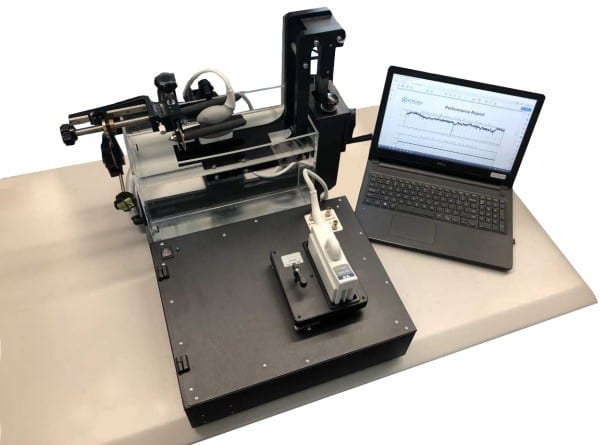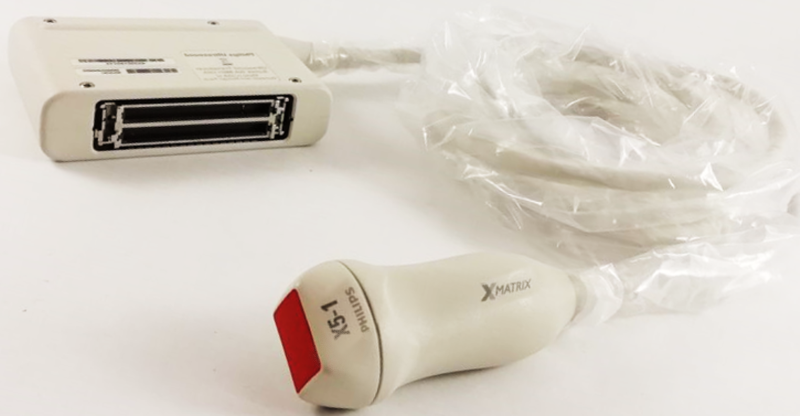Enigma No More: Breakthrough Method for Element Testing the Philips X5-1
 In a market filled with various ultrasonic probe models, healthcare providers understand not all are created equal. For those seeking a staple echocardiographic probe in the upper echelon of devices, the Phillips X5-1 is a proven stalwart. This probe is a distinguished choice from a proven OEM — but that doesn’t mean it’s without issues.
In a market filled with various ultrasonic probe models, healthcare providers understand not all are created equal. For those seeking a staple echocardiographic probe in the upper echelon of devices, the Phillips X5-1 is a proven stalwart. This probe is a distinguished choice from a proven OEM — but that doesn’t mean it’s without issues.
One issue with the X5-1 was the challenge it presented for testing to determine the precise cause of failure. 2D Matrix Array probes have been notoriously difficult to troubleshoot, and the X5-1 is a two-dimensional matrix array probe with more than 3,000 elements. Without some means for testing individual internal components, it’s next to impossible to know what to repair — until now.
 Meet the Phillips X5-1
Meet the Phillips X5-1
Built with xMATRIX and PureWave crystal technologies, the Philips X5-1 is among the most reliable probes available today. It represents an investment in quality for diagnosticians, but it’s prone to many of the same problems that plague other matrix models. Lens damage, strains, cable pulls, connector damage, electronic failures, and trauma can all render the probe faulty.
With 3,040 total elements working together to power the Philips X5-1, narrowing down the source of fault has proven exceptionally challenging. Simple problems — such as damage to the spring tension of the pins — are easy to visually assess, but more often the problem lies with the matrix array itself. Piezoelectric elements cannot be evaluated without sophisticated equipment, and even with that equipment, testing and diagnosing the precise problem with something as intricate as the X5-1 is a complex undertaking.
While it has a well-deserved reputation for highly accurate, superior-caliber imaging, the X5-1 is a delicate piece of technology. Understanding the exact nature of a fault involves a complicated and cryptic assessment process.
 Testing modes are traditionally rudimentary
Testing modes are traditionally rudimentary
The complexity of the Philips X5-1 and some of its more sophisticated malfunctions observed in hospital settings — such as noisy spectral waveforms while in the CW Doppler mode — made duplicating these issues in the repair lab difficult. Without the ability to duplicate these symptoms, technicians cannot accurately isolate the cause of failure or resolve the issue. Often, technicians attempting to reproduce a malfunction for assessment inadvertently cause more damage, thus compounding the problem.
The challenges associated with diagnosing the exact cause of the failure of the Philips X5-1 have long been deterrents to fixing it. Successful attempts at repair previously relied as much on luck as skill. The ability to isolate the components and safely test the electronics simply did not exist, and this forced probe owners into one of two costly predicaments: Replace the probe or continue to use it despite increasingly troublesome faults. Neither option is acceptable.
 The solution
The solution
Unraveling the Philips X5-1 riddle calls for a focus on diagnostics. Understanding the problem starts with isolating and assessing the piezoelectric components for a clear picture of where the fault lies — and how it impacts probe function.
With a device as intricate as the X5-1, understanding the fault is half the battle. Root cause analysis must lend itself to an informed repair or replacement. Whether the fault lies in the probe’s connection or within the array itself, successful repair starts with qualifying the scope of the fault to determine the best approach to resolution. In some cases, this means component replacement, and in others, it’s simply a precision repair.
Acertara Labs’ ATLAS diagnostic system is a breakthrough, patented diagnostic approach that tests the array element by element to distinguish faulty components with extraordinary accuracy, expedite repairs, and keep costs low for the clinicians and patients who rely on the X5-1. ATLAS cracks the code of the complex Philips X5-1 and enables a world of new repair possibilities.
To learn more about Acertara’s revolutionary diagnostic technology, contact Acertara Labs today.

 Meet the Phillips X5-1
Meet the Phillips X5-1 Testing modes are traditionally rudimentary
Testing modes are traditionally rudimentary The solution
The solution